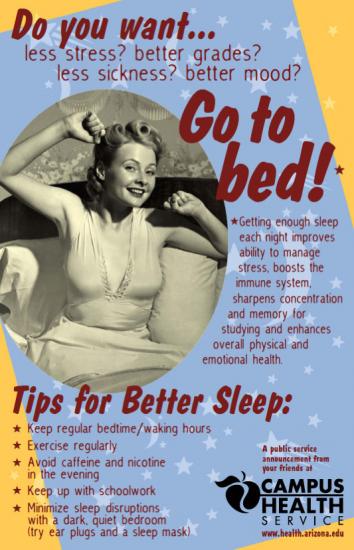
A campus media campaign at the University of Arizona–Tucson was effective in raising sleep as a health issue and in getting students to sleep better and longer.Credit: University of Arizona
The roots of the problem include poor teen sleep habits that do not allow for enough hours of quality sleep; hectic schedules with after-school activities and jobs, homework hours and family obligations; and a clash between societal demands, such as early school start times, and biological changes that put most teens on a later sleep-wake clock.
Previous studies have shown that a correlation exists between short sleep and obesity, but until now few have been able to rule out other variables such as time spent watching television and being physically active. The new study observed over 1,000 Philadelphia-area high school students from their freshmen through senior high school years. At six month intervals, study participants were asked to report their sleep patterns. At the same intervals heights and weights were reported and BMIs were calculated. Study authors suggest the results could have far-reaching implications and aid in reducing the high levels of adolescent obesity in the United States.
“The psychosocial and physical consequences of adolescent obesity are well documented, yet the rate has more than tripled over the last four decades,” says lead author Jonathan A. Mitchell, PhD, postdoctoral fellow in the Center for Clinical Epidemiology and Biostatistics at the Penn Medicine. “What we found in following these adolescents is that each additional hour of sleep was associated with a reduced BMI for all participants, but the reduction was greater for those with higher BMIs. The study is further evidence to support that getting more sleep each night has substantial health benefits during this crucial developmental period.”
Overall, researchers noted the strength of the association between sleep and BMI was weaker at the lower tail of the BMI distribution, compared to the upper tail. For example, each additional hour of sleep was associated with only a slight reduction in BMI (0.07 kg/m2) at the 10th BMI percentile. In comparison, at the 50th percentile a higher reduction in BMI was observed (0.17 kg/m2), and at the 90th percentile an even greater reduction in BMI was observed (0.28 kg/m2). Importantly, the relationship between sleep duration and BMI remained after adjusting for time spent in front of computer and television screens and being physically activity, leading to the conclusion that more sleep could contribute to the prevention of adolescent obesity, even if national screen time and physical activity guidelines are met.
Based on the results, the authors suggest that increasing sleep from 8 to 10 hours per day at age 18 could result in a 4 percent reduction in the number of adolescents with a BMI above 25 kg/m2. At the current population level, a 4 percent reduction would translate to roughly 500,000 fewer overweight adolescents.
“Educating adolescents on the benefits of sleep, and informing them of sleep hygiene practices have shown to have little impact on adolescent sleep duration,” said Mitchell. “One possible solution could be for high schools to delay the start to the school day. Previous research has shown that delaying the start of the school day even by 30 minutes results in a 45-minute per day increase in sleep. Since our study shows increasing sleep by an hour or more could lead to a lower BMI, delaying the start of the school day could help to reduce obesity in adolescents.”
Perelman School of Medicine at the University of Pennsylvania
 Although no exact formula for marital bliss exists, a University of Missouri researcher has found that husbands and wives are happier when they share household and child-rearing responsibilities. However, sharing responsibilities doesn’t necessarily mean couples divide chores equally, said Adam Galovan, a doctoral student in the MU Department of Human Development and Family Studies.
Although no exact formula for marital bliss exists, a University of Missouri researcher has found that husbands and wives are happier when they share household and child-rearing responsibilities. However, sharing responsibilities doesn’t necessarily mean couples divide chores equally, said Adam Galovan, a doctoral student in the MU Department of Human Development and Family Studies.